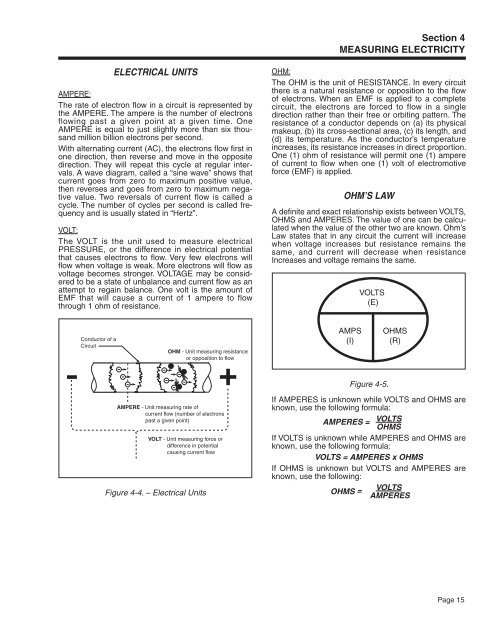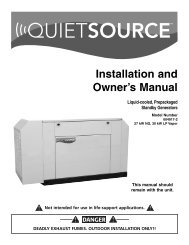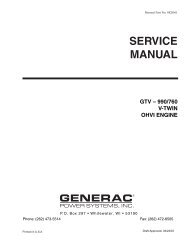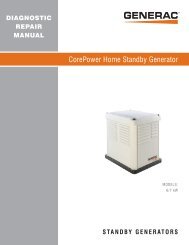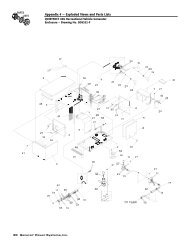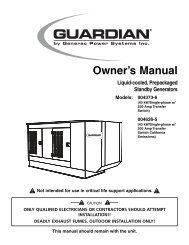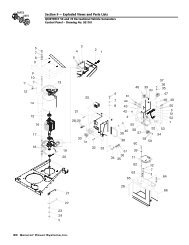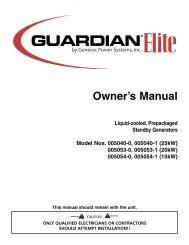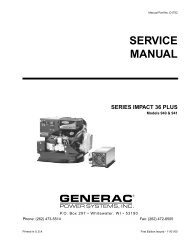Quietpact 40G Diagnostic Repair Manual Model 4700 - Generac Parts
Quietpact 40G Diagnostic Repair Manual Model 4700 - Generac Parts
Quietpact 40G Diagnostic Repair Manual Model 4700 - Generac Parts
You also want an ePaper? Increase the reach of your titles
YUMPU automatically turns print PDFs into web optimized ePapers that Google loves.
Section 4<br />
MEASURING ELECTRICITY<br />
Electrical Units<br />
AMPERE:<br />
The rate of electron flow in a circuit is represented by<br />
the AMPERE. The ampere is the number of electrons<br />
flowing past a given point at a given time. One<br />
AMPERE is equal to just slightly more than six thousand<br />
million billion electrons per second.<br />
With alternating current (AC), the electrons flow first in<br />
one direction, then reverse and move in the opposite<br />
direction. They will repeat this cycle at regular intervals.<br />
A wave diagram, called a “sine wave” shows that<br />
current goes from zero to maximum positive value,<br />
then reverses and goes from zero to maximum negative<br />
value. Two reversals of current flow is called a<br />
cycle. The number of cycles per second is called frequency<br />
and is usually stated in “Hertz”.<br />
VOLT:<br />
The VOLT is the unit used to measure electrical<br />
PRESSURE, or the difference in electrical potential<br />
that causes electrons to flow. Very few electrons will<br />
flow when voltage is weak. More electrons will flow as<br />
voltage becomes stronger. VOLTAGE may be considered<br />
to be a state of unbalance and current flow as an<br />
attempt to regain balance. One volt is the amount of<br />
EMF that will cause a current of 1 ampere to flow<br />
through 1 ohm of resistance.<br />
Conductor of a<br />
Circuit<br />
OHM - Unit measuring resistance<br />
or opposition to flow<br />
- +<br />
AMPERE - Unit measuring rate of<br />
current flow (number of electrons<br />
past a given point)<br />
vOLT - Unit measuring force or<br />
difference in potential<br />
causing current flow<br />
Figure 4-4. – Electrical Units<br />
OHM:<br />
The OHM is the unit of RESISTANCE. In every circuit<br />
there is a natural resistance or opposition to the flow<br />
of electrons. When an EMF is applied to a complete<br />
circuit, the electrons are forced to flow in a single<br />
direction rather than their free or orbiting pattern. The<br />
resistance of a conductor depends on (a) its physical<br />
makeup, (b) its cross-sectional area, (c) its length, and<br />
(d) its temperature. As the conductor’s temperature<br />
increases, its resistance increases in direct proportion.<br />
One (1) ohm of resistance will permit one (1) ampere<br />
of current to flow when one (1) volt of electromotive<br />
force (EMF) is applied.<br />
Ohm’s Law<br />
A definite and exact relationship exists between VOLTS,<br />
OHMS and AMPERES. The value of one can be calculated<br />
when the value of the other two are known. Ohm’s<br />
Law states that in any circuit the current will increase<br />
when voltage increases but resistance remains the<br />
same, and current will decrease when resistance<br />
Increases and voltage remains the same.<br />
AMPS<br />
(I)<br />
VOLTS<br />
(E)<br />
Figure 4-5.<br />
OHMS<br />
(R)<br />
If AMPERES is unknown while VOLTS and OHMS are<br />
known, use the following formula:<br />
AMPERES = VOLTS<br />
OHMS<br />
If VOLTS is unknown while AMPERES and OHMS are<br />
known, use the following formula:<br />
VOLTS = AMPERES x OHMS<br />
If OHMS is unknown but VOLTS and AMPERES are<br />
known, use the following:<br />
OHMS = VOLTS<br />
AMPERES<br />
Page 15


